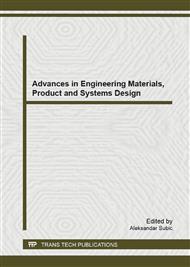[1]
S. Dadbakhsh, L. Hao, N. Sewell, Effect of selective laser melting layout on the quality of stainless steel parts, Rapid Prototyping Journal. 18 (2012) 241 - 249.
DOI: 10.1108/13552541211218216
Google Scholar
[2]
C. Emmelmann, P. Scheinemann, M. Munsch, V. Seyda, Laser Additive Manufacturing of Modified Implant Surfaces with Osseointegrative Characteristics, Physics Procedia 12. Part A (2011) 375-384.
DOI: 10.1016/j.phpro.2011.03.048
Google Scholar
[3]
L. Thijs, F. Verhaeghe, T. Craeghs, J.V. Humbeeck, J. -P. Kruth, A study of the microstructural evolution during selective laser melting of Ti–6Al–4V, Acta Materialia. 58 (2010) 3303-3312.
DOI: 10.1016/j.actamat.2010.02.004
Google Scholar
[4]
I. Yadroitsev, I. Yadroitsava, P. Bertrand, I. Smurov, Factor analysis of selective laser melting process parameters and geometrical characteristics of synthesized single tracks, Rapid Prototyping Journal. 18 (2012) 201-208.
DOI: 10.1108/13552541211218117
Google Scholar
[5]
S. Van Bael, G. Kerckhofs, M. Moesen, G. Pyka, J. Schrooten, J.P. Kruth, Micro-CT-based improvement of geometrical and mechanical controllability of selective laser melted Ti6Al4V porous structures, Materials Science and Engineering. A 528 (2011).
DOI: 10.1016/j.msea.2011.06.045
Google Scholar
[6]
B. Baufeld, O.V. d. Biest, R. Gault, Additive manufacturing of Ti–6Al–4V components by shaped metal deposition: Microstructure and mechanical properties, Materials and Design 31. 1 (2010) S106-S111.
DOI: 10.1016/j.matdes.2009.11.032
Google Scholar
[7]
T. Vilaro, C. Colin, J. Bartout, As-Fabricated and Heat-Treated Microstructures of the Ti-6Al-4V Alloy Processed by Selective Laser Melting, Metallurgical and Materials Transactions. A 42 (2011) 3190-3199.
DOI: 10.1007/s11661-011-0731-y
Google Scholar
[8]
L. Facchini, E. Magalini, P. Robotti, A. Molinari, S. Höges, K. Wissenbach, Ductility of a Ti-6Al-4V alloy produced by selective laser melting of prealloyed powders, Rapid Prototyping Journal. 16 (2010) 450-459.
DOI: 10.1108/13552541011083371
Google Scholar
[9]
L. Qian, J. Mei, J. Liang, X. Wu, Influence of position and laser power on thermal history and microstructure of direct laser fabricated Tiâ€6Alâ€, 4V samples, Materials Science and Technology. 21 (2005) 597-605.
DOI: 10.1179/174328405x21003
Google Scholar
[10]
F. Wang, J. Mei, X. Wu, Microstructure study of direct laser fabricated Ti alloys using powder and wire, Applied Surface Science. 253 (2006) 1424-1430.
DOI: 10.1016/j.apsusc.2006.02.028
Google Scholar
[11]
B. Baufeld, E. Brandl, O. van der Biest, Wire based additive layer manufacturing: Comparison of microstructure and mechanical properties of Ti–6Al–4V components fabricated by laser-beam deposition and shaped metal deposition, Journal of Materials Processing Technology. 211 (2011).
DOI: 10.1016/j.jmatprotec.2011.01.018
Google Scholar
[12]
E. Brandl, A. Schoberth, C. Leyens, Morphology, microstructure, and hardness of titanium (Ti-6Al-4V) blocks deposited by wire-feed additive layer manufacturing (ALM), Materials Science and Engineering. A 532 (2012) 295-307.
DOI: 10.1016/j.msea.2011.10.095
Google Scholar
[13]
L.E. Murr, S.A. Quinones, S.M. Gaytan, M.I. Lopez, A. Rodela, E.Y. Martinez, D.H. Hernandez, E. Martinez, F. Medina, R.B. Wicker, Microstructure and mechanical behavior of Ti–6Al–4V produced by rapid-layer manufacturing, for biomedical applications, Journal of the Mechanical Behavior of Biomedical Materials. 2 (2009).
DOI: 10.1016/j.jmbbm.2008.05.004
Google Scholar
[14]
S. Bontha, N.W. Klingbeil, P.A. Kobryn, H.L. Fraser, Effects of process variables and size-scale on solidification microstructure in beam-based fabrication of bulky 3D structures, Materials Science and Engineering. A 513–514 (2009) 311-318.
DOI: 10.1016/j.msea.2009.02.019
Google Scholar
[15]
P.A. Kobryn, S.L. Semiatin, Microstructure and texture evolution during solidification processing of Ti–6Al–4V, Journal of Materials Processing Technology. 135 (2003) 330-339.
DOI: 10.1016/s0924-0136(02)00865-8
Google Scholar
[16]
P.A. Kobryn, E.H. Moore, S.L. Semiatin, The effect of laser power and traverse speed on microstructure, porosity, and build height in laser-deposited Ti-6Al-4V, Scripta Mater. 43 (2000) 299-305.
DOI: 10.1016/s1359-6462(00)00408-5
Google Scholar
[17]
X. Wu, J. Liang, J. Mei, C. Mitchell, P.S. Goodwin, W. Voice, Microstructures of laser-deposited Ti–6Al–4V, Materials and Design. 25 (2004) 137-144.
DOI: 10.1016/j.matdes.2003.09.009
Google Scholar
[18]
J.P. Kruth, G. Levy, F. Klocke, T.H.C. Childs, Consolidation phenomena in laser and powder-bed based layered manufacturing, CIRP Annals - Manufacturing Technology. 56 (2007) 730-759.
DOI: 10.1016/j.cirp.2007.10.004
Google Scholar
[19]
P.A. Kobryn, S.L. Semiatin, Mechanical Properties of Laser-Deposited Ti-6Al-4V, in D.L. Bourell, R.H. Crawford, H.L. Marcus, J.W. Barlow (Eds) Proceddings of the 12th Solid Freeform Fabrication Symposium, Austin, Texas, August, 2001, pp.179-186.
Google Scholar
[20]
M.P. Bendsoe, O. Sigmund, Topology optimization: Theory, methods and applications, Springer, Paris, (2004).
Google Scholar
[21]
X.E. Guo, C.H. Kim, Mechanical consequence of trabecular bone loss and its treatment: A three-dimensional model simulation, Bone. 30 (2002) 404-411.
DOI: 10.1016/s8756-3282(01)00673-1
Google Scholar
[22]
K. Ushijima, W. Cantwell, R. Mines, S. Tsopanos, M. Smith, An investigation into the compressive properties of stainless steel micro-lattice structures, Journal of Sandwich Structures and Materials. 13 (2011) 303-329.
DOI: 10.1177/1099636210380997
Google Scholar
[23]
S. Hyun, A.M. Karlsson, S. Torquato, A.G. Evans, Simulated properties of Kagomé and tetragonal truss core panels, International Journal of Solids and Structures. 40 (2003) 6989-6998.
DOI: 10.1016/s0020-7683(03)00350-0
Google Scholar
[24]
P. Moongkhamklang, V.S. Deshpande, H.N.G. Wadley, The compressive and shear response of titanium matrix composite lattice structures, Acta Materialia. 58 (2010) 2822-2835.
DOI: 10.1016/j.actamat.2010.01.004
Google Scholar
[25]
M. Leary, M. Babaee, M. Brandt, A. Subic, Feasible Build Orientations for Self-Supporting Fused Deposition Manufacture: A Novel Approach to Space Filling Geometries, Advances in Engineering Materials, Product and Systems Design, Trans Tech Publications Ltd, Switzerland, (2012).
DOI: 10.4028/www.scientific.net/amr.633.148
Google Scholar


